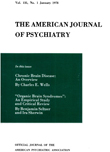THE EEG. IN LATE POST-TRAUMATIC CASES
Abstract
About one-half (48%) of late post-traumatic cases have abnormal EEGs. The presence of fracture or unconsciousness does not appreciably alter this percentage. Post-traumatic cases with epilepsy have a higher percentage of abnormal EEGs. and post-traumatic cases with headache have a lower percentage of abnormal EEGs. than the average. Post-traumatic cases with psychosis have a slightly greater percentage of abnormal EEGs. than do those without psychosis.
Late post-traumatic cases suffering primarily from headaches have essentially the same percentage abnormality of EEGs. as non-traumatic cases suffering primarily from headaches. Late post-traumatic cases suffering from psychosis (organic reaction type) have essentially the same percentage abnormality as non-traumatic cases suffering from organic psychosis. Late post-traumatic cases suffering primarily from epilepsy have essentially the same percentage abnormality as non-traumatic cases suffering from epilepsy.
In almost all post-traumatic cases having evidence of focal abnormality by ERG. either (1) the focus corresponded to the area of injury, (2) a fracture or skull deformity was found at the site of the focus, or (3) Jacksonian seizures were present involving the side opposite the focus.
Access content
To read the fulltext, please use one of the options below to sign in or purchase access.- Personal login
- Institutional Login
- Sign in via OpenAthens
- Register for access
-
Please login/register if you wish to pair your device and check access availability.
Not a subscriber?
PsychiatryOnline subscription options offer access to the DSM-5 library, books, journals, CME, and patient resources. This all-in-one virtual library provides psychiatrists and mental health professionals with key resources for diagnosis, treatment, research, and professional development.
Need more help? PsychiatryOnline Customer Service may be reached by emailing [email protected] or by calling 800-368-5777 (in the U.S.) or 703-907-7322 (outside the U.S.).



